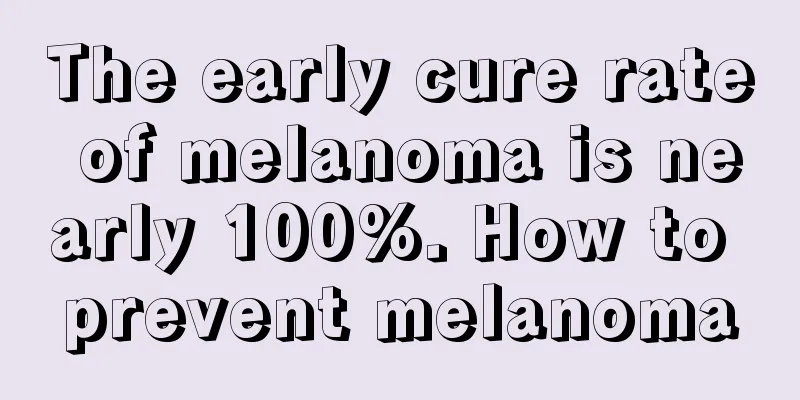The early cure rate of melanoma is nearly 100%. How to prevent melanoma

|
The five-year cure rate for early-stage melanoma is close to 100%, while the five-year survival rate for patients in the late stage is only 5% to 10%. If you find any of the following changes in your moles, you must be highly alert. If moles on the body show these conditions, be alert that they may turn into melanoma 1. The area or volume suddenly increases, and the color becomes darker or changes. 2. Redness, swelling and inflammation of the pigmented nevus or its surrounding area. 3. The pigmented nevus begins to grow asymmetrically, for example, one side is larger than the other side, or one side is darker than the other side. 4. The surface changes from smooth to rough, and may even ulcerate, ooze, and bleed. 5. Several small black dots suddenly appear around a pigmented mole, which is called a satellite mole. 6. A mole suddenly feels itchy and painful. How to prevent melanoma 1. Pay attention to ultraviolet radiation Clinically, ultraviolet radiation is one of the causes of malignant melanoma. Ultraviolet rays are very sensitive to DNA damage and can lead to a decrease in systemic immunity. Many data support the pathogenic effects of sunlight and ultraviolet rays. Some people believe that there is insufficient evidence that sunlight causes melanoma and have proposed the sunlight cycle factor hypothesis, which holds that sunlight exposure causes the body to produce a factor that circulates with the blood to other parts of the body, stimulating melanocytes to become malignant. 2. Pay attention to the protection or treatment of existing pigmented nevi It is also important to pay attention to the protection of existing pigmented nevi or to carry out scientific treatment in time in order to prevent melanoma. It is well known that junctional nevi and junctional components in mixed nevi can be malignant and transform into melanoma. Junctional nevi are mainly the phenotype of pigmented nevi on the skin of infants or children. They rarely become malignant before puberty. After puberty, most junctional nevi have turned into intradermal nevi. Only a few parts such as the palms, soles, scrotum, and labia still retain the characteristics of junctional nevi in adults. Therefore, these nevi have the greatest potential for malignant transformation. |
<<: What are the causes of osteofibroma
>>: What is the difference between melanoma and mole?
Recommend
What is cervical cancer
Nowadays, many female friends are very tired. Com...
Three Chinese medicine prescriptions for the treatment of ovarian cancer
Ovarian cancer is a common gynecological tumor th...
Scraping therapy for skin cancer using new technology
For the treatment of more stubborn skin cancer, w...
A woman only does it once a month, and she still looks like a flower fairy at the age of 40
For women, health care should be carried out at d...
How can melanoma be diagnosed
How can melanoma be diagnosed? Melanoma is a skin...
Pain in the corner of the eye near the nose
Nowadays, more and more people are beginning to f...
What should I do if I have difficulty breathing due to qi deficiency?
Qi deficiency and difficulty breathing. Tradition...
A low-fat, high-protein diet is recommended for patients with colorectal cancer
Intestinal cancer is a malignant tumor of the dig...
Is it good to eat mango when you have a cold? What effect will it have?
Generally speaking, it is not recommended to eat ...
Is mediastinal cystic teratoma likely to be malignant?
The malignancy rate of mediastinal cystic teratom...
What is the role of chemical cellulose?
Cellulose is a nutrient widely found in various f...
The functions and effects of hemp seed oil
Many people don't know much about hemp seed o...
What to do if you can't sleep after drinking milk tea
Many friends suffer from insomnia after drinking ...
What should patients with myocardial infarction eat? Eating these will make your heart attack healthier
Myocardial infarction is a common cardiovascular ...
Symptoms of egg white allergy, take it seriously
Generally speaking, adults are not allergic to eg...









